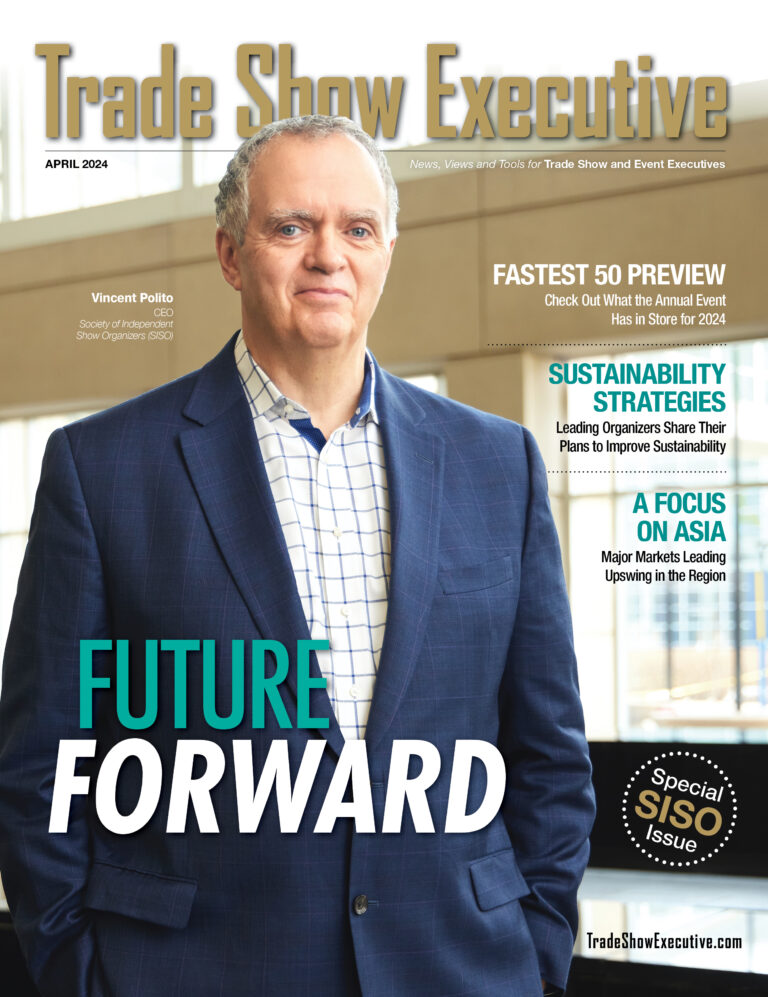 How will trade show organizers position themselves for growth after the COVID-19 pandemic? Once travel bans, stay-at-home orders, and prohibitions on group meetings started taking hold, organizers that were able flipped to a virtual format out of sheer necessity. However, only 38% of respondents to a recent PCMA Compass report said they prefer digital to face-to-face events.
How will trade show organizers position themselves for growth after the COVID-19 pandemic? Once travel bans, stay-at-home orders, and prohibitions on group meetings started taking hold, organizers that were able flipped to a virtual format out of sheer necessity. However, only 38% of respondents to a recent PCMA Compass report said they prefer digital to face-to-face events.
While the world hopes that the global COVID-19 vaccination rollout will bring with it a quick return to in-person shows, only 28% of PCMA Compass respondents said they expected more than a 10% increase in their on-site events.
So, will the future be digital, in-person, or hybrid? What future challenges still await as we work our way back to some semblance of normality? TSE asked executives from independent trade show organizers and associations to share their growth strategies as well as their perspectives on the challenges facing the industry as we move into whatever the “new normal” will be.
Related. Growth Strategies: TSE’s Annual Outlook
 Informa Markets: Focusing on safety and customer value
Informa Markets: Focusing on safety and customer value
Charlie McCurdy, CEO
Given the disruption of events caused by COVID-19 in 2020 and into 2021, what strategies are you planning to use to recover and potentially grow your in-person events?
We plan to be more indispensable than ever to our markets.
In the near-term, we are prioritizing safety above all else, and visitors to our in-person shows can expect a highly controlled environment as we run events in accordance with government and local health authority guidance, as well as our Informa AllSecure guidelines.
With the robust return of our substantial Mainland China business, and live events returning gradually in Florida, Japan, Thailand, Egypt, and elsewhere, a picture of the path to a post-pandemic environment is taking shape.
We’re returning to live events with better customer value than ever. Both our sell-side and buy-side customers are benefitting from the expanded data-driven digital services we have developed at an accelerated pace during the pandemic. We’ve been fortunate to have had a well-developed digital media business, especially in the U.S., which we’re building upon.
We are able to offer new ways to participate in our events and to broaden reach through virtual and hybrid experiences. We have grown our existing online marketplaces and introduced many new ones, offering niche industries a single platform to showcase their products and services to qualified buyers. We have also expanded our audience and media solutions to help customers reach highly targeted audiences. And we have grown our databases to offer customers more and smarter connections. These are all areas we will continue to focus on in 2021 and beyond. It’s why we changed our name from Informa Exhibitions to Informa Markets: our role is to improve the flow of commercial activity in the sectors we serve.
Data is also central to our growth strategy. We are investing in our data capabilities, upskilling our people, tailoring solutions to our customers’ needs and rolling out a Data Literacy program for all Informa Markets colleagues later this year.
What role do you anticipate digital and/or hybrid events will play in your growth strategies moving forward?
We are delivering a full, highly coordinated twin-channel approach to our business: live and digital.
Digital product development and the further strengthening of our digital and data capabilities will remain absolutely central to our strategy in 2021 and beyond. A hybrid experience is an enhanced experience. For our sell-side customers, it brings new opportunities and new audiences, without the constraints of a show floor. Likewise, for our buy-side customers, the power of face-to-face will always remain essential; live events offer unique and vital benefits.
I’ve always seen the fusion of trade shows and digital services as a natural evolution: we are offering our participants the same experience they’ve come to expect in their day-to-day lives. We offer the chance to connect with and research products and suppliers online before making a purchasing decision and that, coupled with the option to participate virtually (if they are not able to be there in-person), and the opportunity to continue the connection all year-round. We had this working really well at Canon (now Informa Markets’ Engineering group) more than a decade ago, and data management has come a long way since then.
What do you anticipate will be the biggest challenges for the trade show market in general and your portfolio specifically in the near term?
In geographies where we were able to run in-person events in the second half of 2020, such as mainland China, Japan, Taiwan, Hong Kong, Dubai, Egypt, and some states in the U.S., participation in our events was mainly domestic. However, we were able to open those shows up to international audiences through complementary virtual experiences. Into 2021, we are seeing the disruption to international travel continue, and having invested in developing hybrid solutions that offer our customers alternate ways to connect with their communities remains essential.
In the near-term, rebuilding confidence in the safety and security of in-person trade events is vital, both to our industry, the industries we serve, and the economies of our host cities around the world. As we see a gradual and phased return to in-person and hybrid events, we are focused on proving the efficacy of the Informa AllSecure standards to create that assurance and allow us to re-connect and reinvigorate those communities.
How might the current state of the geopolitical, pandemic, and economic landscape affect the growth of your event portfolio through 2021?
As the vaccine and testing programs continue to roll out in markets worldwide, we are optimistic that 2021 will be a year of recovery for the events industry. Our aim is to make the most of in-person event opportunities as they arise, where we have permission to host them from the relevant authorities, and where we have the confidence of our customers to join us there.
We decided to postpone most of our in-person events outside of Asia into the second quarter of 2021 and beyond and I believe this strategy will serve us and our customers well. Our focus remains on retaining the strength of our brands and developing products and solutions that meet the needs of our customers.
 Emerald: Advocating for the value of face-to-face shows
Emerald: Advocating for the value of face-to-face shows
Hervé Sedky, President and CEO
Given the disruption of events caused by COVID-19 in 2020 and into 2021, what strategies are you planning to use to recover and potentially grow your in-person events?
2020 presented our world with the rise and spread of COVID-19, which continues to be a devastating, ever-present reality for our industry. Last year also provided our industry with some hard learning: that very little was known about the exhibitions industry and our overall economic impact on a local, state and federal level. As a result, we united to educate and drive awareness of the important role the exhibitions industry plays in our economy. Emerald will remain firmly committed to SISO, the Go Live Together initiative, and the trade show industry in the wake of the COVID-19 pandemic by supporting legislative advocacy efforts to facilitate industry recovery. Our industry is a foundational element of how business gets done, and 2021 provides us with the opportunity to amplify this message which will fuel our recovery and allow our in-person events to grow and flourish.
What do you anticipate will be the biggest challenges for the trade show market in general and your portfolio specifically in the near term?
We are faced with challenges that are out of our control coupled with an unpredictable future, both professionally and personally. These challenges range from the overall recovery rate of the pandemic, successful rollout of the vaccination, to the state-by-state COVID-19 related restrictions regarding reopening plans, all of which are crucial to the recovery of the events industry. These complexities revealed the need for us to work harder than ever before to deliver on initiatives that we at Emerald believe in and can control. Our focus is to identify how we can better serve our customers, our communities, and the industries they serve while producing secure, safety-first live events and 365-day channels for our industries to connect, create and grow their businesses.
 Reed Exhibitions (RX) Americas: Focus on the things we can control — customer value, safety, and expanded access
Reed Exhibitions (RX) Americas: Focus on the things we can control — customer value, safety, and expanded access
Given the disruption of events caused by COVID-19 in 2020 and into 2021, what strategies are you planning to use to recover and potentially grow your in-person events?
Our primary focus has always been, and will continue to be, our customers. Our events are designed to serve their needs, and we have continually engaged with our customers throughout the year to ensure that we understand what they want and need in order to be productive and move their businesses forward. RX made rapid and considerable progress in 2020 by offering digital solutions across many of our brands. This enabled us to offer value in new ways and to reach new customers through digital matchmaking, brand activations and fully virtual events. Moving forward, our year-round efforts will continue to provide valuable and relevant content and will connect these communities to generate real business outcomes.
As we return to the face-to-face event in 2021 (as we fully expect to do!), we anticipate that they will look and feel different than in the past. The health and safety of our colleagues, partners and audiences remains our number-one priority. We have developed a global strategy and a five-point enhanced health and safety plan for all of our events, and this will continue to evolve and keep pace with the evolving pandemic and the most up-to-date thinking from the relevant authorities.
What role do you anticipate digital and/or hybrid events will play in your growth strategies moving forward?
We expect that all RX events will continue to offer a combination of digital, hybrid, and face-to-face opportunities to connect and do business. The digital events we produced in 2020 introduced us to new technologies and new customers. And, while these digital tools have enabled us to keep our communities connected through the pandemic, we are also optimistic about the possibilities they offer to extend the relevance and reach of our physical events, too. We are committed to delivering value to our customers in whatever way they choose to engage, and we have trained and hired our staff to ensure we can deliver the most valuable experiences on the various platforms. We are no longer a “meet once a year” industry, and we look forward to engaging our communities year-round.
What do you anticipate will be the biggest challenges for the trade show market in general and your portfolio specifically in the near term?
As an industry, we need to remind ourselves, our people, our customers, and our stakeholders of the importance of our industry. The marketplaces we create, whether digitally or in person, will play a key role in the recovery of the U.S. economy. Our survey results tell us that customers on both sides of the aisle are eager to return to trade shows, and that they look to us to provide them with the access information and interactions that help propel their businesses forward. We must work to earn their trust and confidence so that we can return to face-to-face events safely, in whatever this new normal looks like, and reassure everyone that we can protect the health of those who attend.
How might the current state of the geopolitical, pandemic, and economic landscape affect the growth of your event portfolio through 2021?
The pandemic certainly changed the industry and the way we do business. I believe the best way forward for RX is to focus on the things we can control. We will focus on our people and continue to develop their skillsets and provide opportunities for growth. We will continue to bring value to our customers, and we will continue to develop new ways to help them engage.
 National Business Aviation Association (NBAA): Looking forward, lingering concerns
National Business Aviation Association (NBAA): Looking forward, lingering concerns
Chris Strong, Senior Vice President, Conventions and Membership
Given the disruption of events caused by COVID-19 in 2020 and into 2021, what strategies are you planning to use to recover and potentially grow your in-person events?
This has been an interestingly reaffirming time with regard to what our attendees and exhibitors find most valuable about live events. NBAA, like most associations, has been able to create value for attendees virtually around educational content, high-level keynotes and some entertainment. We have found comparatively modest success, however, in helping the industry engage with itself — network — the virtual setting. The experience has been much the same for exhibitors/sponsors. Branding and product announcement opportunities have been well received, but despite a significant investment, we have not been able to consistently drive exhibitor/attendee engagement or, more importantly, sales for our exhibitors. We will be highly focused on maximizing the elements everyone has missed as we are all able to come back together.
What role do you anticipate digital and/or hybrid events will play in your growth strategies moving forward?
We have learned a great deal about how to produce wonderful educational content online — truly valuable and well-attended sessions and keynotes. We plan on incorporating what I would call a “delayed-hybrid” model moving later into the year. I don’t see us necessarily taking on the expense of delivering live, streaming content, but I do foresee adding a proficiency in repackaging our live content for distribution after our trade shows and conferences. This will allow us to reach a broader audience, particularly internationally, and add value for sponsors.
What do you anticipate will be the biggest challenges for the trade show market in general and your portfolio specifically in the near term?
Probably the unpredictability for a year or more. Systemically, we have all become pretty good at understanding how a trade show or conference will perform based upon prior years, locations and market conditions. I am bullish that shows will do well as we recover, but we will all be guessing a bit more than we are comfortable with in regard to a true recovery. I can make the case for a slower than anticipated pickup over the next 12 months, but I can make an equal case for a larger than anticipated resurgence due to pent-up demand. We are pretty conservative, but these types of conversations drive our CFO nuts.
How might the current state of the geopolitical, pandemic, and economic landscape affect the growth of your event portfolio through 2021?
We run two significant international events. It is easy to anticipate that many companies and individuals will be comfortable traveling to events domestically before they become comfortable heading to Geneva and Shanghai. Among factors for this is that many domestic travel restrictions will be lifted before international restrictions. This will be a challenge.
I am also concerned about how the pandemic has affected a number of the show service companies (decorators, AV, stand-builders, etc.) that we have come to rely upon. As best I can tell, most of them seem to have remained in business, but many have had to lay off or release key staff members. This I understand, but we have had the opportunity to work with and count on a number of wonderful professionals that may not be with us as we rebuild. I don’t think the effects of this change should be underestimated.
 Consumer Technology Association: Time to get real about recovery
Consumer Technology Association: Time to get real about recovery
Gary Shapiro, Gary Shapiro, President and CEO
Given the disruption of events caused by COVID-19 in 2020 and into 2021, what strategies are you planning to use to recover and potentially grow your in-person events?
We spent 2020 planning for 2021, especially CES (the Consumer Electronic Show). The plan was that 2020 would be digital, and 2021 would be hybrid, and then we reimagined CES to make it purely digital. Hybrid events combine the advantages of digital with those of physical events, but it is a complex undertaking and an investment of resources.
The truth is the needle has shifted: People are never going to go back to the way it was.
So the question we have to ask ourselves is what can motivate them to get back to our shows? Our challenge will be to create a value proposition that encourages participation in our physical shows, but also enhances that participation digitally and globally. Our strategy will be focused on providing a comfortable, hygienic event that people want to come to and we already have over 1,000,000 square feet sold to exhibitors that are signed up for CES 2022. And we are going to figure out how to preserve the best of what we’ve done digitally while continuing to produce a compelling, excellent physical event.
What do you anticipate will be the biggest challenges for the trade show market in general and your portfolio specifically in the near term?
The biggest challenge is unrealistic expectations: that we’ll go back to what we had before. It will be the challenge of the economy and the entire travel and exhibition vertical. The trade show industry has to face the reality that – whether it’s the economy, corporate travel budgets, or the comfort level of employees – it’s not going to immediately spring back to what we had in 2019 and early 2020, before the pandemic. It’s going to be a gradual moving forward with limited physical events and we have to figure out how to make people feel comfortable at them.
It’s not as if a switch will be flipped and everyone has herd immunity, so we’re fine. We will have to identify those who are vaccinated, perhaps also those who had COVID. We have to deal with how long we continue with masking and how we hold people accountable. We have to deal with how we redo our floor plans to get social distancing. Then there’s vaccine distribution, privacy issues, global rules on travel, which are very restricted now; how to keep airlines and hotels healthy, the availability of skilled workers, convention centers that are ready to come back, and restaurants ready to open.
There are so many moving pieces that it will be a slow and, perhaps steady return to a version of normalcy that is a little less robust than what we had just a year and a half ago.
How might the current state of the geopolitical, pandemic, and economic landscape affect the growth of your event portfolio through 2021?
With the other challenges, we also are facing a new administration with a divided country. We have a new Congress that is considering all sorts of regulatory changes. We have rising global tensions with Russia and China, economic and unemployment issues, and, when we get to the aftermath of the pandemic, some people may not want to travel again. We will see.
The industry is going to face some stress, but eventually people will realize that they still need face-to-face meetings and that serendipity and the five-sense experience that only a live meeting can provide.
 Clarion Events North America: Unlocking new ways to meet market needs
Clarion Events North America: Unlocking new ways to meet market needs
Greg Topalian, CEO
Given the disruption of events caused by COVID-19 in 2020 and into 2021, what strategies are you planning to use to recover and potentially grow your in-person events?
The disruption really provided Clarion with an opportunity to take a step back to ensure we had our pulse on the markets we serve and today’s customer needs, and then align our teams’ focus to deliver high-value products to meet those needs. The exciting piece for Clarion is that we have been able to change our product mix in a very meaningful way that not only has helped to unlock new ways to deliver customer value, but will also be part of the evolution of our business as we move into 2021 and beyond. The common focus in all that we are doing is providing meaningful personalized connections, whether that be through digital content series, hosted-guaranteed meetings programs, showroom product demonstrations, or on-demand membership-based learning platforms. Those connections today are helping us to grow our audience and prepare for the return to live events.
What role do you anticipate digital and/or hybrid events will play in your growth strategies moving forward?
Digital has opened so many doors for the industry and customers are getting more comfortable with digitally led experiences. We all know 2021 will be slower to return and we anticipate lower attendance. Keeping that in mind, our teams are creating digital experiences that complement our live shows to provide communities with the connections, learning, and access they need year-round. For those who cannot attend in person, when we do return to live, this opens a door for a new way to engage markets and geographies we haven’t been able to access before.
Our hosted buyer business with Quartz Events has proven meaningful connections can happen, both in person and digitally, and has delivered close to 20,000 virtual meetings in just six months. We see the meeting potential is something that will really take off as we go forward and will prove especially meaningful for attendees and exhibitors who are not able to be with us in person.
What do you anticipate will be the biggest challenges for the trade show market in general and your portfolio specifically in the near term?
I believe the biggest challenge for the industry as a whole is that if you haven’t evolved your business models, haven’t thought about digital as a long-term play rather than a short-term fix, then you will continue to face a more challenging marketplace in which to conduct business. Our customers want to return to live events, but those who cannot be with us will be looking for alternative ways to connect and you need to be ready to engage with them because there are now many more opportunities to meet their needs (other trade shows, exhibitor-lead events, and even non-trade show–focused companies stepping into the markets) and even more customers that you can reach through digital opportunities.
For Clarion in particular, we’ve spent almost all of last year testing, iterating, and refining some of our newer business models, so I feel really good about where we are there and where my teams are headed. We’ve got a very meeting-centric focus for all our events this year, which I’m excited to see further develop. For my portfolio, the return to live is something we spend lots of time focusing on. There has been a lot of positivity around the vaccines and testing capabilities and we were fortunate to run two live events at the end of 2020. Our next event is taking place in February, so not only do we know we can, we are seeing more customers sharing the same feeling that they too are ready to return to safe, in-person events.
How might the current state of the geopolitical, pandemic, and economic landscape affect the growth of your event portfolio through 2021?
I feel cautiously optimistic. While the return to where we were with live events before the pandemic will take time to build back, the work my teams have done to diversify, to innovate and find new ways to connect customers with a broader range of product offerings will allow Clarion to see growth in new areas in 2021.
 Avixa, the audiovisual and integrated experience association, producer of InfoComm trade shows, co-owner of Integrated Systems Europe: Redefining strategic plans
Avixa, the audiovisual and integrated experience association, producer of InfoComm trade shows, co-owner of Integrated Systems Europe: Redefining strategic plans
Rochelle Richardson, Senior Vice President, Exhibition and Event Services
Given the disruption of events caused by COVID-19 in 2020 and into 2021, what strategies are you planning to use to recover and potentially grow your in-person events?
The global pandemic has significantly impacted every aspect of the exhibitions and events industry. AVIXA and its global portfolio of trade shows has also been impacted. The pandemic required that we redefine the association’s strategic plans for in-person events. As a first step in this process, we studied the data and research from reputable third-party research providers about the industry and attendees and exhibitors to make informed business decisions. We are focused on a digital strategy and ability to serve the needs of trade show attendees, members, and the professional AV industry globally and offering customization based on regions.
Lastly, we have set realistic expectations that traditional key performance indicators (KPIs) of size and year-over-year growth may take us time to get back to pre-pandemic levels and therefore have replaced them with a more sustained business model for our trade shows to create quality experiences for people in our industry, to connect and network safely in person, to see products and new technologies up close, and to provide a physical or digital environment for our customers to resume business.
What role do you anticipate digital and/or hybrid events will play in your growth strategies moving forward?
With an increase in trade shows and events cancelling and/or postponing over the past year, we had to pivot quickly to incorporate a digital offering and decided to go virtual for InfoComm 2020. We have all experienced a surge in digital, virtual and hybrid options over the past 12 months, new creative and innovative enhancements, and more options to choose from — but more does not equate to satisfied customers. In fact, the research confirms there is virtual fatigue, virtual formats are not as effective and are not fulfilling the expectations of exhibitors.
While we anticipate digital, virtual and hybrid offerings to be a part of our strategy moving forward, they will not replace the advantages of physical trade shows and events.
What do you anticipate will be the biggest challenges for the trade show market in general and your portfolio specifically in the near term?
One of the challenges for the exhibitions and events industry will be projections for the industry to rebound. The future of trade shows will be and look different than before, with a focus on quality over quantity and with a few extra health and safety protocols in place for now. Although we are already seeing a few organizers move forward with their physical trade shows, we will likely continue to see virtual and/or hybrid offerings through the remainder of this year. With the increase in widespread distribution and administration of vaccines in the U.S., I do expect trade shows to rebound in 2022 and beyond.
Reach Charlie McCurdy at +44 0 20 7017 5000 or Charlie.mccurdy@informa.com; Hervé Sedky at (203) 840-5584 or hsedky@reedexpo.com; Fernando Fischer at (203) 840-4800 or ffischer@reedexpo.com; Gary Shapiro at (703) 907-7600 or gshapiro@cta.tech; Greg Topalian at (203) 550-2139 or greg@leftfieldmedia.com; Chris Strong at (202) 478-7765 or cstrong@nbaa.org; and Rochelle Richardson at (703) 273-7200 or rrichardson@avixa.org.











